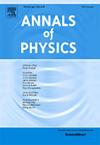Modeling of Hybrid Baryonic-Quark Matter in f(R) Gravity with scalar potential
IF 3
3区 物理与天体物理
Q2 PHYSICS, MULTIDISCIPLINARY
引用次数: 0
Abstract
This paper investigates the characteristics of static, anisotropic self-gravitating structures composed of baryonic matter coupled with the strange quark matter in the background of gravity. To describe the relationship between pressure and matter density for the quark matter configuration, we employ the MIT bag model. In our analysis, we articulated the system of field equations by incorporating the MIT bag model alongside a linear equation of state in a specific gravitational model. The Tolman–Kuchowicz metric potentials are used to model these fluids, and the constants are calculated by applying junction conditions, with the Schwarzschild geometry serving as the exterior solution. We thoroughly examined the physical validity of the derived solution by investigating the metric functions, matter components, energy conditions, hydrostatic equilibrium, and stability criteria. For the comprehensive graphical analysis, we fixed numerical values, including the bag constant and other parameters for nine compact star candidates. Consequently, our proposed model meets all important stability criteria and physical conditions, providing the solid basis for exploring the characteristics of hybrid stars.
具有标量势的f(R)重力下重子-夸克混合物质的建模
研究了f(R,ϕ,X)重力背景下由重子物质与奇异夸克物质耦合组成的静态各向异性自引力结构的特性。为了描述夸克物质组态的压力和物质密度之间的关系,我们采用了MIT袋模型。在我们的分析中,我们通过将MIT袋模型与特定引力模型中的线性状态方程结合起来,阐述了f(R,ϕ,X)场方程系统。Tolman-Kuchowicz度量势用于模拟这些流体,并通过应用结条件计算常数,以史瓦西几何作为外部解。我们通过研究度量函数、物质成分、能量条件、流体静力平衡和稳定性标准,彻底检查了导出解的物理有效性。为了进行全面的图形分析,我们对9颗候选致密星进行了固定的数值计算,包括袋常数和其他参数。因此,我们提出的模型满足所有重要的稳定性标准和物理条件,为探索混合恒星的特征提供了坚实的基础。
本文章由计算机程序翻译,如有差异,请以英文原文为准。
求助全文
约1分钟内获得全文
求助全文
来源期刊

Annals of Physics
物理-物理:综合
CiteScore
5.30
自引率
3.30%
发文量
211
审稿时长
47 days
期刊介绍:
Annals of Physics presents original work in all areas of basic theoretic physics research. Ideas are developed and fully explored, and thorough treatment is given to first principles and ultimate applications. Annals of Physics emphasizes clarity and intelligibility in the articles it publishes, thus making them as accessible as possible. Readers familiar with recent developments in the field are provided with sufficient detail and background to follow the arguments and understand their significance.
The Editors of the journal cover all fields of theoretical physics. Articles published in the journal are typically longer than 20 pages.
 求助内容:
求助内容: 应助结果提醒方式:
应助结果提醒方式:


